Heraldry with Charles J Burnett – Queen’s Herald in Scotland
- NATURAL HISTORY IN HERALDRY
The days are getting longer and soon it will be Spring when new growth will appear from the ground as nature prepares for another annual cycle. The plant life around us has provided a source of inspiration for heralds when new Arms were required. Trees, plants, flowers, and vegetables, all appear on coats of arms, sometimes rendered naturalistically, at other times depicted as stylised forms.
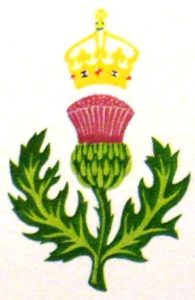 |
Although regarded by many as a weed, the thistle was chosen by James III, King of Scots, as his royal Plant Badge c1471. Since then the thistle has become synonymous with Scottish identity and has been interpreted by artists and designers in a huge number of ways.
The Scottish Rugby Team sport a thistle on their strip and numerous coats of arms feature the thistle to show national identity. The Queen still uses the crowned Thistle Badge on the silver used in the Dining Room at the Palace of Holyroodhouse. |
| The St Andrews Fund for Scots Heraldry was set up in 2000 to encourage the study and practice of heraldry. Since then over £95,000 has been distributed to support the original ideals. Naturally the Fund petitioned the Lord Lyon for a grant of arms which consists of the St Andrew’s Cross surrounded by a border of thistles on a red background to symbolise the martyrdom of Saint Andrew. This arrangement echoes the royal tressure which consists of two parallel lines decorated with fleurs-de-lis which alternately point inwards and outwards. |
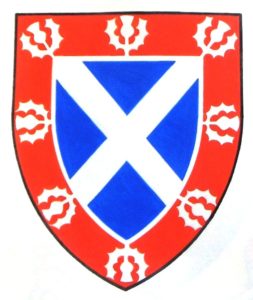 |
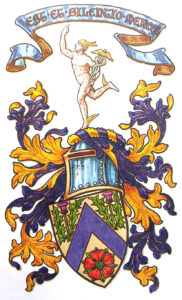 |
In 1902 James Findlay of Aberlour was granted these Arms which incorporate both thistles and a red rose. The crest consists of Mercury, the messenger of the gods who carried information between the deities. The Findlay family owned The Scotsman newspaper when it really was a national organ of information, and one member, James Findlay, was responsible for underwriting the construction of the Scottish National Portrait Gallery in Edinburgh.
This happened in the last decade of the nineteenth century which had witnessed a remarkable era of private philanthropy to benefit the common weal. We do not experience the same benevolence from private sources today. |
| Another Scottish family which features roses in their Arms are the Dunbars from the south-east of Scotland. The family are cadets of a more senior line and had to differentiate their Arms by adding a silver bordure round the central shield bearing a lion. The bordure was then decorated with eight roses. This system of distinguishing members of the same family is called cadency and the use of bordures is very much a Scottish practice. Portugal is another country where bordures are found – they are seldom seen in English heraldry. The principal rule in heraldry is that no two people can use the same coat of arms, and this is very strictly enforced by the Lord Lyon King of Arms. |
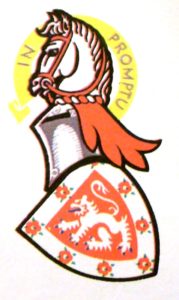 |
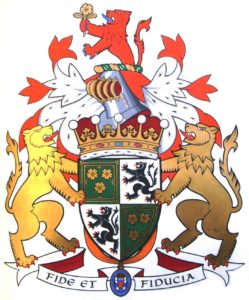 |
To continue the flower theme I next feature the Arms of Primrose, Earl of Rosebery. This is an example of punning Arms as the main charges are primrose flowers, and the crest has a lion holding a primrose. The Primrose family eventually acquired the Rosebery and Barnbougle estate just north of Edinburgh on the south side of the Firth of Forth by the 16th century and were made peers in the 16th century. Eventually during the 19th century the 6th Earl of Rosebery became Prime Minister and married into the wealthiest Jewish family in England – the Rothschilds. |
|
|
|
| Leaves are also found in heraldry; in Canada the maple leaf is the national plant badge, in Scotland docken leaves are used as charges, and in the case of the Burnetts holly leaves have appeared on Burnett seals since the 13th century. Once the Burnetts were granted the hunting lands of Leys on Deeside by King Robert the Bruce which the family had to manage, the hunting horn became their symbol of office as royal foresters. The horn was then added to the Arms. The crest of the Burnetts of Leys features another plant – the vine. Just as the vine is harvested for grapes so do the Burnetts wisely harvest their resources. The crest translates as “Strength draws vigour from an injury”.
|
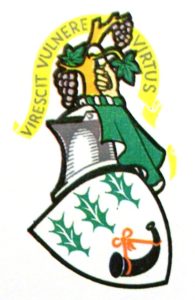 |
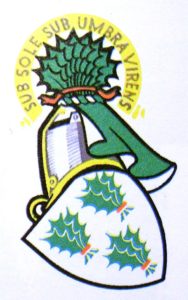 |
The Irvine family were also granted the lands of Drum by King Robert the Bruce which marches with the Leys estate. Although the families have been neighbours for over 600 years no marriage has taken place between a Burnett and an Irvine!
The Irvines also use holly leaves in their Arms which are grouped as three bunches of three leaves on the shield, with a large bunch of leaves for a crest.
There is an excellent 15th century carved version of the Irvine of Drum Arms to be found on the wall of the Drum Aisle in St Nicholas’, the ‘Mither Kirk’ of Aberdeen. As with the ancestral home of the Burnetts, Crathes Castle, the Irvine Castle of Drum is now managed by the National Trust for Scotland. |
| From individual leaves to whole trees, an oak tree eradicated [and often fructed] is a charge found in both Scottish and Italian heraldry. Eradicated means torn out with the roots showing and fructed indicates the oak tree bears acorns. Such were the Arms of Pope Julius II who gave Scotland its Sword of State. The Sword bears the papal Arms. The MacGregors in Scotland have an oak tree bearing roots, but no acorns, coupled with a sword and crown.
The family were outlawed at the beginning of the 17th century and many were forced to change their surname, amongst their number was the notorious bandit Rob Roy MacGregor. In 1775 the clan MacGregor was restored finally to their rightful name |
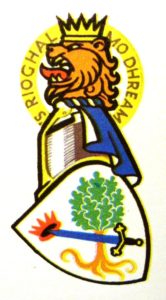 |
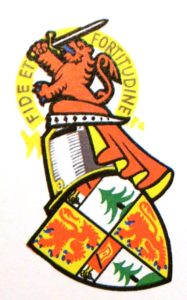 |
Scots Pines feature in the Arms of Farquharson of Invercauld who have been associated with Deeside since the 14th century. A Donald Farquharson married Isobel Stewart, heiress of Invercauld, and thus inherited that estate. The King then made him keeper of the royal forests of Braemar and thus the pine tree was adopted as part of the Arms. The family owned Braemar Castle, a tower house near the Burgh of Braemar which is now owned and run by the Braemar community as a tourist attraction. Recently Invercauld House, seat of the Farquharsons, was put on the market for sale. |
| Plants are harvested as food, or for the production of various kinds of drinks. Cereal crops were once cut by hand, gathered into bundles, “stooks” in Doric, and stood up in fields to dry. A bundle of corn is called a garb in heraldry and three garbs have featured in the Arms of the Comyns since the 12th century. At one time the Comyns were the most powerful family in Scotland and owned vast tracts of fertile lands including Buchan. Their power and influence were destroyed by Robert the Bruce in his struggle to become King of Scots. Comyn heraldry can still be seen on various buildings in Aberdeenshire, such as Pitsligo Castle near Rosehearty and Pittendrum House at Sandhaven by Fraserburgh. |
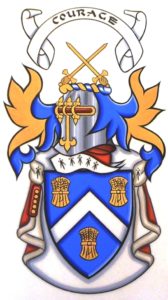 |
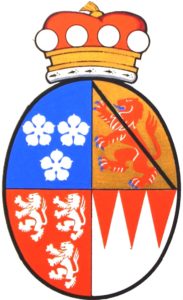 |
The last Arms to be featured are those of Flora Fraser, Lady Saltoun. She is Chief of the Frasers and the first quarter of her Arms shows the Fraser armorial bearings. This consists of three cinquefoils, the heraldic term for a stylised strawberry flower. In French a strawberry is a fraise so from that word derives the surname Fraiser, or Fraser. Thus fruit are also included in the heraldic lexicon, from strawberries to grapes to apples to oranges and to pomegranates. Vegetables are also featured, the most common in the United Kingdom being the leek of Wales.
Natural history is yet another facet of the world which has been absorbed into the science of heraldry, and next month we will look at another quite different area, namely the religious use of armory. |














